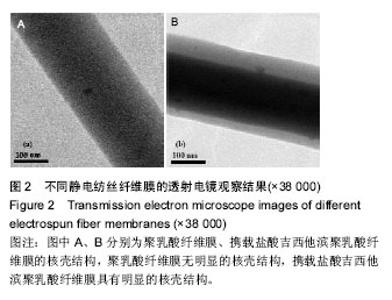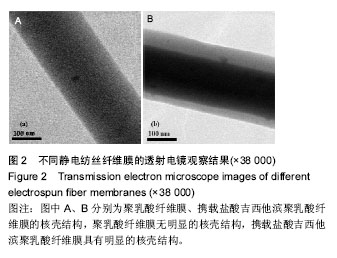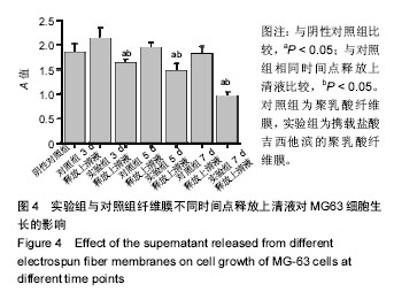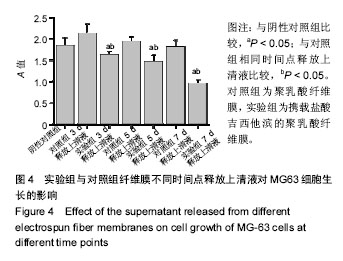| [1] 胡晓晖,施鑫,吴苏稼.骨肉瘤误诊为动脉瘤样骨囊肿二例分析并文献复习[J].中国骨与关节杂志,2011,10(5):525-527.[2] 汪新媛,田京.骨肉瘤化疗研究进展[J].国际骨科学杂志, 2010, 31(3):159-161.[3] 王翌庆,丁克峰.大剂量甲氨蝶呤多药联合治疗骨肉瘤不良反应的处理和分析[J].实用肿瘤杂志, 2009,24(4):407-410.[4] 许建波,杨祚璋,肖砚斌.全股骨人工假体置换治疗右股骨骨肉瘤一例[J].中华肿瘤防治杂志,2007,14(3):239-240.[5] 王浩,陈学思,邓英杰.吉西他滨聚L-乳酸中空微球的制备及其酶解释放行为研究[J].中国药剂学杂志:网络版,2011,9(2): 21-29.[6] 张振兴,杜鸿达,李佳,等.静电纺丝制备定向排列聚酰亚胺基炭纳米纤维[J].新型炭材料,2015, 30(4):289-294.[7] 刘俊,常梦洁,杜慧玲.静电纺丝制备SU-8光刻胶纳米纤维及图案阵列[J].高分子材料科学与工程,2016, 32(4):121-125.[8] 单晓茜,刘昌胜,欧阳春发,等.可降解聚合物抗菌纤维膜的原位制备及性能表征[J].科学技术与工程,2015, 15(4):180-185.[9] 钱宇娜,李林昊,蒋超,等.静电纺丝天然-人工合成聚合物复合纳米纤维及其对细胞黏附、增殖和迁移的影响[J].功能材料, 2012, 43(18):2473-2477.[10] 马利婵,王娇娜,李丽,等.静电纺空气过滤用PET/CTS抗菌复合纳米纤维膜的制备[J].高分子学报,2015,59(2):221-227.[11] Hasan A,Yildirimer L,Hobson D,et al.Tissue‐Engineered Human Skin Equivalents and Their Applications in Wound Healing.Tissue Engineering for Artificial Organs.Wiley‐VCH Verlag GmbH & Co.KGaA,2017:215-241.[12] 杨春宇,陈思浩,楼建中,等.静电纺纳米复合纤维在气体传感器中的应用研究进展[J].化工新型材料,2016,44(6):13-15.[13] 徐衍,包崇云.静电纺丝技术在牙周组织再生中的应用[J].口腔医学研究,2015,31(11):1159-1163.[14] 李丽,关小倩,李静,等.吉西他滨对晚期癌症的治疗效果[J].中国癌症杂志,2000,10(6):575-576.[15] Ciccolini J,Serdjebi C,Peters GJ,et al.Pharmacokinetics and pharmacogenetics of Gemcitabine as a mainstay in adult and pediatric oncology: an EORTC-PAMM perspective.Cancer Chemother Pharmacol. 2016;78(1):1-12.[16] 韩志超,许杉杉,佴刚.一种负载有靶向抗癌药物的PLGA微米颗粒的制备方法:CN103599073A[P].2014.[17] 胡旭昌,王栓科,康学文,等.吉西他滨对人骨肉瘤细胞增殖及肿瘤转移相关基因1mRNA表达的影响[J].中国全科医学, 2013, 16(29):3450-3452.[18] 颜慧琼,陈秀琼,李嘉诚,等.海藻酸盐水凝胶作为组织工程支架材料改性与应用研究进展[J].化工新型材料, 2017,45(3):28-30.[19] 范洁,李岩,周苏波,等.用静电纺丝制备PCL/明胶新型组织工程支架用于人鼻中隔软骨修复研究[J].浙江临床医学, 2016,18(10): 1831-1833.[20] 尹合勇,孙振,李盼,等.Cytodext-3微载体/藻酸钠水凝胶作为可注射性支架构建组织工程软骨的可行性[J].中国组织工程研究, 2016,20(34):5104-5109.[21] 王小毅,张诚.丝素蛋白—壳聚糖支架在组织工程中的应用新进展[J].中国美容整形外科杂志,2017, 28(4):244-245.[22] 王鹏燕,叶雅静,何进,等.制备大孔径静电纺丝组织工程支架的研究进展[J].现代生物医学进展,2015, 15(1):155-159.[23] 王玉姣,田明伟,曲丽君.静电纺丝纳米纤维的应用与发展[J].成都纺织高等专科学校学报,2016, 33(4):1-16.[24] 虞希高,陈正坚,蒋宏亮,等.静电纺丝小直径人造血管机械力学性质[J].中国生物医学工程学报,2010,29(5):770-776.[25] 王浩,温梦,康卫民,等. W/O乳液静电纺丝法制备盐酸环丙沙星聚L-乳酸纤维膜及表征[J].沈阳药科大学学报, 2016,33(6): 426-433.[26] Zhao X, Yuan Z, Yildirimer L,et al. Tumor-Triggered Controlled Drug Release from Electrospun Fibers Using Inorganic Caps for Inhibiting Cancer Relapse. Small. 2015; 11:4284-4291.[27] Cheng L, Sun X, Hu C, et al. In vivo inhibition of hypertrophic scars by implantable ginsenoside-Rg3-loaded electrospun fibrous membranes. Acta Biomaterialia. 2013;9:9461.[28] Yoshimoto H, Shin YM, Terai H,et al. A biodegradable nanofiber scaffold by electrospinning and its potential for bone tissue engineering. Biomaterials. 2003;24:2077-2082.[29] Shin M, Ishii O, Sueda T, et al. Contractile cardiac grafts using a novel nanofibrous mesh. Biomaterials. 2004;25:3717-3723.[30] Kim K, Yu M, Zong X, et al. Control of degradation rate and hydrophilicity in electrospun non-woven poly( d , l -lactide) nanofiber scaffolds for biomedical applications. Biomaterials. 2003;24:4977-4985.[31] Mo XM, Xu CY, Kotaki M, et al. Electrospun P(LLA-CL) nanofiber: a biomimetic extracellular matrix for smooth muscle cell and endothelial cell proliferation. Biomaterials. 2004;25:1883.[32] Xu CY, Inai R, Kotaki M,et al. Aligned biodegradable nanofibrous structure: a potential scaffold for blood vessel engineering. Biomaterials. 2004;25(5):877-886.[33] Xu C, Inai R, Kotaki M, et al.Electrospun nanofiber fabrication as synthetic extracellular matrix and its potential for vascular tissue engineering. Tissue Eng. 2004;10(7-8):1160-1168[34] Katti DS, Robinson KW, Ko FK, et al. Bioresorbable nanofiber-based systems for wound healing and drug delivery: optimization of fabrication parameters. J Biomed Mater Res B Appl Biomater.2004;70(2):286-296.[35] 罗永慧,赵宁宁,刘漪沦,等.聚乳酸支架材料与角膜上皮样细胞的体外生物相容性[J].四川解剖学杂志, 2015,23(1):1-5.[36] 王延松,范文源.一种新型药物缓释载体——聚乳酸(PLA)生物可降解纤维[J].中华实用医药杂志,2009,9(4):250-253.[37] 蔡沈阳,胡广,任杰.乳丝的加工、性能及其应用[J].生物工程学报, 2016,32(6):786-977.[38] 卢杭诣,崔静,王清清,等.载药同轴静电纺玉米醇溶蛋白/聚乙烯醇-苯乙烯基吡啶盐缩合物复合纳米纤维的制备及性能[J].高分子材料科学与工程, 2016,32(8):131-136.[39] Zhou P, Zhou L, Zhu C, et al. Nanogel-electrospinning for controlling the release of water-soluble drugs. J Mater Chem B.2016;4(12):2171-2178.[40] 顾珊珊,张寒莹,朱嗣文,等.静电纺丝纳米纤维的制备及其蛋白药物缓释体系[J].中国医药工业杂志,2017,48(9):1325-1331.[41] 于锐,徐哲伟,穆容超,等.基于不同载药方式的同轴电纺纤维膜的制备与性能[J].合成纤维,2016, 45(5):23-27.[42] 谢红,卢华,黄华,等.载药聚乙烯醇/海藻酸钠静电纺丝纤维的改性及其药物体外释放研究[J].第三军医大学学报, 2011,33(23): 2485-2489.[43] 周丽佳,徐召南,毕也,等.载顺铂联合氯喹聚乳酸静电纺丝膜对口腔鳞状细胞癌CAL-27细胞增殖的抑制作用[J].吉林大学学报(医学版),2016,42(5):892-896.[44] 何创龙,黄争鸣,韩晓建,等.同轴射流技术制备纳米复合材料研究进展[J].复合材料学报,2005,22(6):1-8.[45] Qiu K,He C,Feng W,et al.Doxorubicin-loaded electrospun poly(L-lactic acid)/mesoporous silica nanoparticles composite nanofibers for potential postsurgical cancer treatment.J Mater Chem B. 2013;1(36):4601-4611.[46] Zeng J,Yang L,Liang Q,et al.Influence of the drug compatibility with polymer solution on the release kinetics of electrospun fiber formulation.J Control Release. 2005;105 (1-2):43-51.[47] Maretschek S,Greiner A,Kissel T.Electrospun biodegradable nanofiber nonwovens for controlled release of proteins.J Control Release.2008;127(2):180-187. [48] Siddiqui WA,Ahad A,Ahsan H.The mystery of BCL2 family: Bcl-2 proteins and apoptosis: an update. Arch Toxicol. 2015; 89(3):289.[49] Xu G,Kuang G,Jiang W,et al.Polydatin promotes apoptosis through upregulation the ratio of Bax/Bcl-2 and inhibits proliferation by attenuating the β-catenin signaling in human osteosarcoma cells.Am J Transl Res.2016;8(2):922. |









